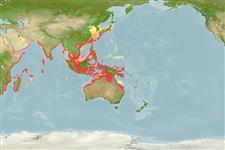>
Carangiformes (Jacks) >
Carangidae (Jacks and pompanos) > Caranginae
Etymology: Parastromateus: Greek, para in the side of + Greek, stromatos = a fish flattened body with a lot of colours (Stromateus sp.) (Ref. 45335).
More on author: Bloch.
Environment: milieu / climate zone / depth range / distribution range
ນິເວດວິທະຍາ
ສັດທະເລ; ນ້ຳກ່ອຍ ກ່ຽວກັນຫີນ; ປາທີ່ມີການເຄື່ອນຍ້າຍຈາກທະເລໄປຫານ້ຳຈືດ ແລະນ້ຳຈືດຫາທະເລ (Ref. 51243); ລະດັບຄວາມເລິກ 15 - 105 m (Ref. 12260), usually 15 - 40 m (Ref. 54702). Tropical; 42°N - 30°S, 32°E - 154°E
Indo-West Pacific: East Africa to southern Japan and Australia.
Length at first maturity / ຂະໜາດ / ນ້ຳໜັກ / Age
Maturity: Lm 23.0, range 22 - 24 cm
Max length : 75.0 cm TL ຕົວຜູ້/ບໍ່ມີເພດ; (Ref. 5284); common length : 30.0 cm TL ຕົວຜູ້/ບໍ່ມີເພດ; (Ref. 3287)
ຄີ (ໜາມ)ແຂງຢູ່ຫຼັງປາ (ທັງໝົດ): 2 - 6; ຄີຫຼັງຂອງປາ (ຄີອ່ອນ) (ທັງໝົດ): 41-46; ຄີ(ໜາມ) ແຂງຢູ່ຄີກົ້ນປາ
ກຸ່ມປາກະດູກແຂງ
ຄວາມຖີ່ຂອງກຸ່ມຖ່າຍທອດພັນ
ປາທີ່ມີການເຄື່ອນຍ້າຍຈາກທະເລໄປຫານ້ຳຈືດ ແລະນ້ຳຈືດຫາທະເລ
ປາທີ່ມີການເຄື່ອນຍ້າຍຈາກທະເລແລະໄປໄຂ່ຢູ່ນ້ຳຈືດ
ຄີກົ້ນຂອງປາ
ສັດທີ່ມີກະດູກສັນຫັຼງ
ການຖ່າຍທອດທາງກຳມະພັນຈາກພໍ່ແມ່ຫາລູກ 2; ຄີກົ້ນຂອງປາ: 35 - 40; ສັດທີ່ມີກະດູກສັນຫຼັງ: 24. Deep-bodied and strongly compressed fishes. Lateral line ends in weakly-developed scutes on the caudal peduncle. Pelvic fins lost in individuals over 9 cm. Color is brown above, silvery-white below. The anterior parts of the dorsal and anal fins bluish-gray. The other fins yellowish.
Adults inhabit coastal areas with muddy substrate. Found near the bottom during daytime and near the surface at night. They also enter estuaries (Ref. 1479). Normally form large schools (Ref. 5213). Swim on its side near the surface (Ref. 3197). Feed on zooplankton (Ref. 30573). Excellent food fish (Ref. 3197); marketed fresh, may be dried or salted (Ref. 5284).
Paxton, J.R., D.F. Hoese, G.R. Allen and J.E. Hanley, 1989. Pisces. Petromyzontidae to Carangidae. Zoological Catalogue of Australia, Vol. 7. Australian Government Publishing Service, Canberra, 665 p. (Ref. 7300)
IUCN Red List Status (Ref. 130435)
Threat to humans
Harmless
Human uses
Warning: mysqli::__construct(): (HY000/1040): Too many connections in /var/www/html/includes/func_getlabel.php on line 46
Can't connect to MySQL database (fbapp). Errorcode: Too many connections
